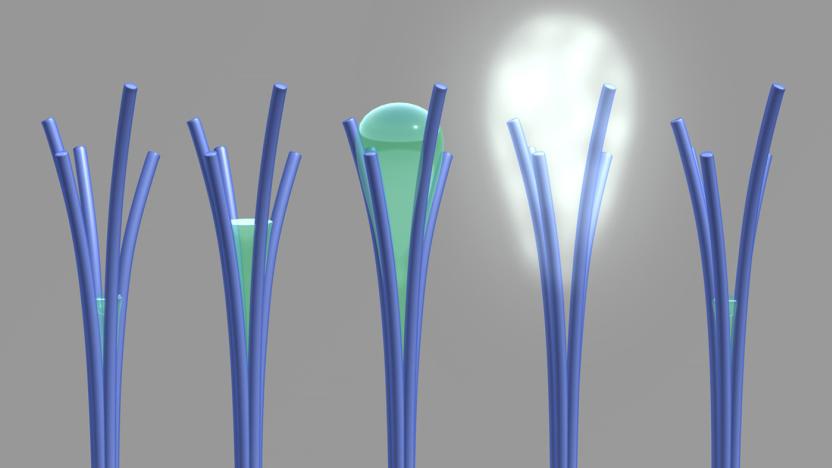PacificNorthwestNationalLaboratory
Latest

ICYMI: An accidental invention could create clean water
Today on In Case You Missed It: Some of the greatest inventions of our modern age, from the pacemaker to super glue, got their start as accidental discoveries. That's why we're focusing today's show on a find by the Pacific Northwest National Laboratory, where scientists meant to make magnetic nanowires but created a kind of carbon nanorod instead. It might prove to be a wonderful mistake, since studying the nanorods shows they can harvest, hold and evaporate liquid from their fibers. The hope is that the material could create cheap and low-energy water purification systems, changing the game for clean water delivery. We also showed you both the YouTube video where a ATM skimmer seller demonstrates how easy it is to scam money from those machines, and also a video of this dancing robot, because. As always, please share any interesting tech or science videos you find by using the #ICYMI hashtag on Twitter for @mskerryd.

Nanorods could harvest water in dry climates
Sometimes it's the accidental discoveries that make the biggest impact. Researchers at Pacific Northwest National Laboratory have learned that carbon-rich nanorods created in a botched experiment might be ideal for harvesting water. When there's relatively low humidity (below 50 percent), the rods trap water inside their gaps; if it's any more humid, however, they promptly expel that water as vapor. It's a very unusual trait that's likely caused by water condensing into a "bridge" in the nanorods, whose surface tension forces them to close and eventually kick the water out.

Fuel cells get stronger, potentially cheaper with graphene, ITO
As the sustainable Juggernaut of fuel cell vehicles (FCV) powers ever forward, a group of scientists are cooking up ways to make the alternative energy source more durable and even cheaper. By combining graphene -- think pencil lead -- and indium tin oxide (ITO) nanoparticles, the team produced a catalytic material that is both stronger and more chemically active than the usual catalytic combo. Fuel cells typically use a chemical catalyst like platinum, sitting atop a base of black carbon or metal oxides, to break down oxygen and hydrogen gases, creating water in the process -- thing is, carbon is easily eroded by the resulting water, and metal oxides, while more stable, are less conductive. Using graphene -- which because of its porousness erodes less quickly -- in combination with the stable ITO and platinum nanoparticles, researchers have created what could be referred to as a super fuel cell -- a stronger, longer lasting, and potentially cheaper version of the alternative energy source. Unfortunately, without enough hydrogen filling stations, these super fuel cells won't come to anyone's rescue anytime soon.

Researchers find weak point in lithium-ion batteries, suggest better nanowires could be the answer
We've seen countless attempts to build a better lithium-ion battery, but there's been far fewer research efforts devoted solely to figuring out why lithium-ion batteries don't last longer. A team of scientists at the Pacific Northwest National Laboratory have been doing just that, however, and they're now sharing some of their findings. The main culprit, they say, are the nano-sized wires made of bulk tin oxide used in the batteries, which can expand and deform considerably over time, eventually rendering the battery useless. What's more, while the research was focused primarily on examining the cause of battery aging, the researchers do naturally have a few suggestions on how to improve them -- namely, to replace those wires made of bulk tin oxide with finer tin oxide nanowires. As lead scientist Chongmin Wang explains, that would effectively amount to winding together "thinner wires rather than making one thick rope," which is of course easier said than done. Head on past the break for the complete press release.

PNNL researchers develop standard smart charger for plug-in vehicles
Developing a charger for a plug-in electric vehicle is hardly anything new, but the folks at the Pacific Northwest National Laboratory (or PNNL, for those in the know) have some considerably grander plans for their new Smart Charger Controller, which they say could one day serve as a standard charger for all sorts of electric vehicles. The key bit, it seems, is that each controller would be wirelessly linked to the local electric utility, which would feed the controller power prices and other information in order to let it charge during non-peak hours -- saving owners about $150 a year in energy costs as a result. It would apparently even be able to sense "stress conditions" and shut down before the grid gets overloaded. Of course, all of this depends on both the automakers and electric utilities getting on board, which could be quite a tall order, especially with another standardized EV plug seemingly already on the fast track.

Scientists convert glucose into fuel and polyesters
Glucose has been the building block for many zany creations 'round these parts, but using the widely available substance to create "products currently created from petroleum" has some fairly far reaching consequences. Gurus at the Pacific Northwest National Laboratory have reportedly "converted sugars ubiquitous in nature into a primary building block for fuel and polyesters," dubbed hydroxymethylfurfural (HMF). Aside from the obvious benefits of finding yet another renewable energy to tap into, learning to harness this power could give garb and plastic manufacturers new routes to source raw materials. So what do the creators themselves think? "The opportunities are endless" -- we say: prove it.




